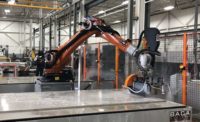Ultra-compact surfaces have been gradually making their way into the market and now are becoming a popular choice for a range of residential and commercial designs. Whether it is being used for cladding or outdoor kitchens, these products have carved a niche out for themselves. Recently, the market has witnessed a newer product in porcelain slabs. According to Stone World’s 2020 annual purchasing plan survey, 13% of fabricators are cutting porcelain, and another 10% are cutting ultra-compact surfaces.
When it comes to both ultra-compact surfaces and porcelain, cutting these materials hasn’t always been an easy task for fabricators. There are special guidelines and blades, as well as other different points to consider and pay attention to when cutting these products. “First, you need to have a solid foundation for cutting,” said Nick Wadenstorer of BACA Systems. “The cutting table is important to make sure that it is solid, flat and prevents material movement during cutting. The next factor is to make sure you are using the right blade. A rigid core blade with minimal spaces between segments minimizes chipping during cutting, along with spinning the blade at the right RPM. It is important to have Variable Frequency Drive (VFD) to adjust the RPM from standard granite and quartz cutting to porcelain materials. Also, the right volume of water can play a key factor. Water shouldn’t just be dripping on the blade or the material, but should be directed at the glow of the blade to cool the point of cutting and expel the eroded material during the erosion/cutting process.”
After a fabricator has dialed in their machine and made sure the blade is getting enough water for the cut, the next thing a fabricator has to look at is the order of the cuts.
“Material manufacturers typically provide cutting parameters, but overall, we hear that trimming the edge of the slab helps relieve tension in the material,” said Wadenstorer. “It is also recommended that you don’t plunge into the middle of material, but always start your blade off the side of the material and work your way into the middle of the slab. With the right blade, table surface, water supply and cutting parameters, blade technology is allowing us to significantly increase blade process speeds from just a year ago.”
Using a blade isn’t the only option though, there may be an easier choice. “If you have a waterjet, we find that it may be more beneficial in some cases to waterjet the entire cut process,” said Wadenstorer. “This is a non-contact cut which doesn’t have downward pressure from the blade. It also eliminates vibration from the segments during the cutting process, which can help prevent cracking. We also see hyper pressure waterjet cutting at 94k psi to double the cut speeds from standard 60k cuts. We feel the future in cutting thin porcelain will be in waterjet cutting.”








